YANGON—Ja Hkawn still remembers the day all the residents of a nearby village were forcibly driven across the river by the local authorities. It was in late May 2010. The villagers of Mali Zup were given just three days to pack their belongings. She saw the villagers carrying their possessions on their shoulders and rounding up their livestock. As they headed to their “new place” across the river, their footsteps were heavy. Some shed tears as they left.
In April of the following year, Ja Hkawn, who was then a resident of Tang Hpre village, faced the same fate as her Mali Zup neighbors. The whole village was forced to move to a new place—Aung Myin Tha, 8 miles to the south.
The reason for the forced relocations: to make way for a mega-dam to be built by China Power Investment Corporation (CPI), now known as State Power Investment Corporation (SPIC).
“I’ve never liked it here—I long to go back to my village,” Ja Hkawn said. She misses her old village located at the confluence of the May Kha and Mali Kha rivers; life is hard in Aung Myin Tha, as the new location is not arable, but built on rocky red soil.
Once a landowner with several acres on which she grew seasonal vegetables, the 53-year-old Kachin woman now—like many others—scratches out a living as a vendor with the support of local NGOs, selling organic soap, local snacks and T-shirts emblazoned with the slogans “No Dam” and “Long Live Irrawaddy” to tourists in Myitsone. One of Kachin State’s major landmarks, and a must-see for visitors to the area, Myitsone is the point at which the confluence of the May Kha and Mali Kha rivers gives rise to Myanmar’s lifeline, The Irrawaddy River. The confluence is recognized by the Organization for World Wildlife Conservation as a place of biodiversity and natural heritage. During a recent visit there, The Irrawaddy witnessed a busload of Chinese tourists visiting the area.
About a 25-minute boat ride south of the source of the Irrawaddy River, the proposed 6,000-megawatt dam is one of the biggest hydropower projects in the region with an estimated cost of US$3.6 billion. CPI started work on the project in 2009 with the construction of resettled villages for displaced locals. The two resettlement villages, Aung Myin Tha and Mali Yang, are located on opposite sides of the Irrawaddy, facing each other.
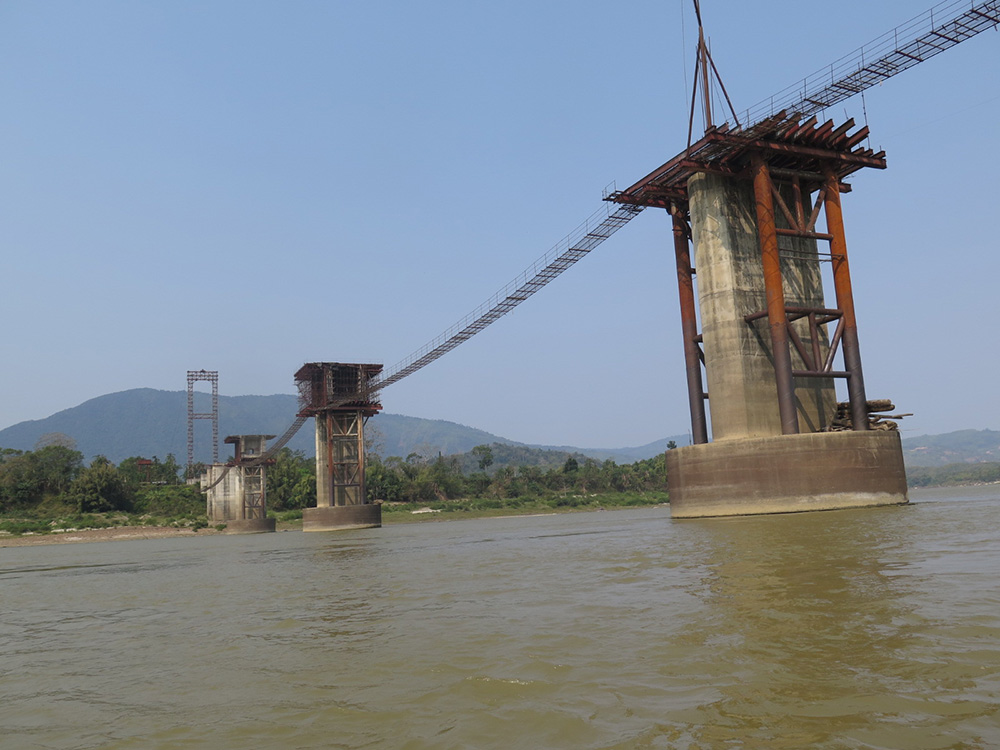
A Memorandum of Understanding (MoU) was signed in December 2006 between the Ministry of Electric Power No. 1 and CPI after a senior member of the ruling military junta, General Thiha Thura Tin Aung Myint Oo, visited China and sought assistance for hydropower development in Myanmar.
After former President Thein Sein took office, strong objections to the project emerged from the public. Environmentalists say the dam site has some of the highest levels of biodiversity in the world and warn that the project would both destroy the natural beauty of the Irrawaddy River and disrupt water flow. They say it could potentially flood an area the size of Singapore, destroying livelihoods and displacing more than 10,000 people.
In September 2011, U Thein Sein announced the suspension of the dam project due to widespread concerns over the environmental and social impacts. However, Beijing, eager to meet its mushrooming power demands, has not given up hope of restarting work on the dam.
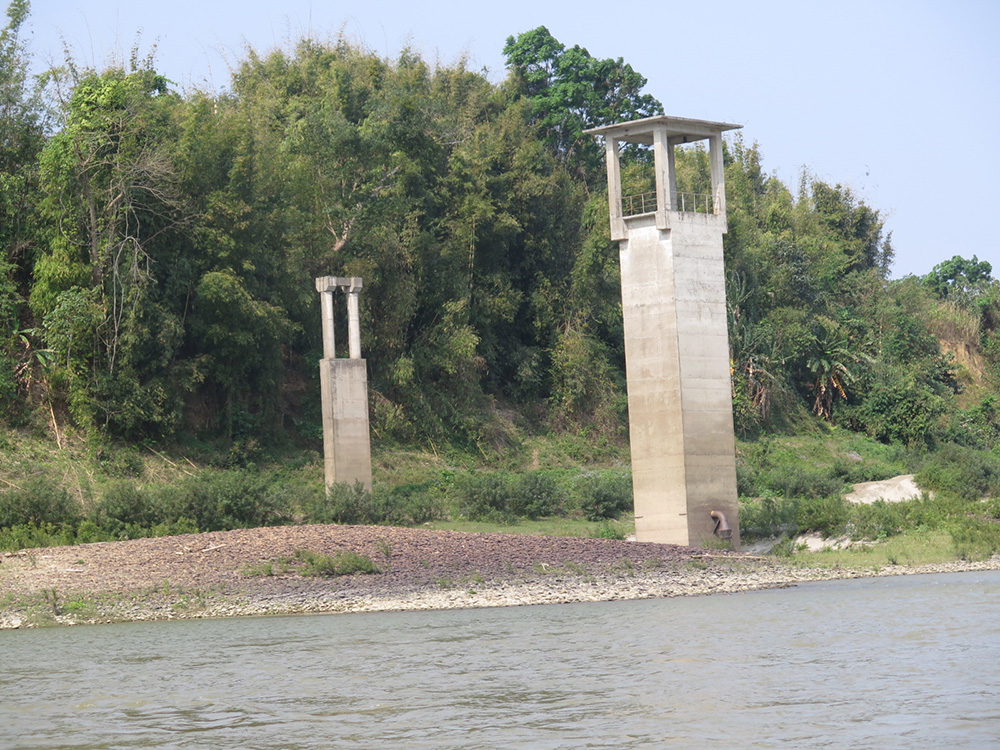
In recent months, Beijing has increasingly showed its hand, pressuring and even threating Kachin religious and political leaders not to oppose the dam project, and confirming that it is part of China’s ambitious Belt and Road Initiative (BRI).
During the 2015 election campaign, then-opposition leader Daw Aung San Suu Kyi promised to make public the terms of the project agreed by the military dictatorship. As State Counselor, however, she has been silent on her own stance on the dam.
Recently, she urged the public to consider the project from “a wider perspective”, saying her government should not abolish projects approved by a previous government just because they do not comply with its own policies. The comment fueled concerns that her government is too quick to bend to Beijing’s will, particularly on the Myitsone dam.
Since November last year, SPIC officials have been knocking on villagers’ doors, inquiring about their needs and claiming that the project will improve local residents’ lives. SPIC met with residents near the Myitsone Dam site to reassure them that its project would be carried out under the supervision of the world’s best dam builders.
“Their actions are not normal. There is whispering among our people that the dam project will restart soon,” Ja Hkawn said.
“We don’t want to take anything from them for the time being,” she said. “[Otherwise] later they will act like they are giving us what we need, and insist that we have to obey them,” she added.
Hardship in a new place
After nearly eight years, villagers still don’t feel settled in Aung Min Tha— a new village constructed by the Chinese company for those displaced by the dam project.
Living in a new environment, going to a new church every Sunday and losing livelihoods that date back generations, they nurture a dream that they will be able to return to their villages one day and that the project will be abandoned forever.
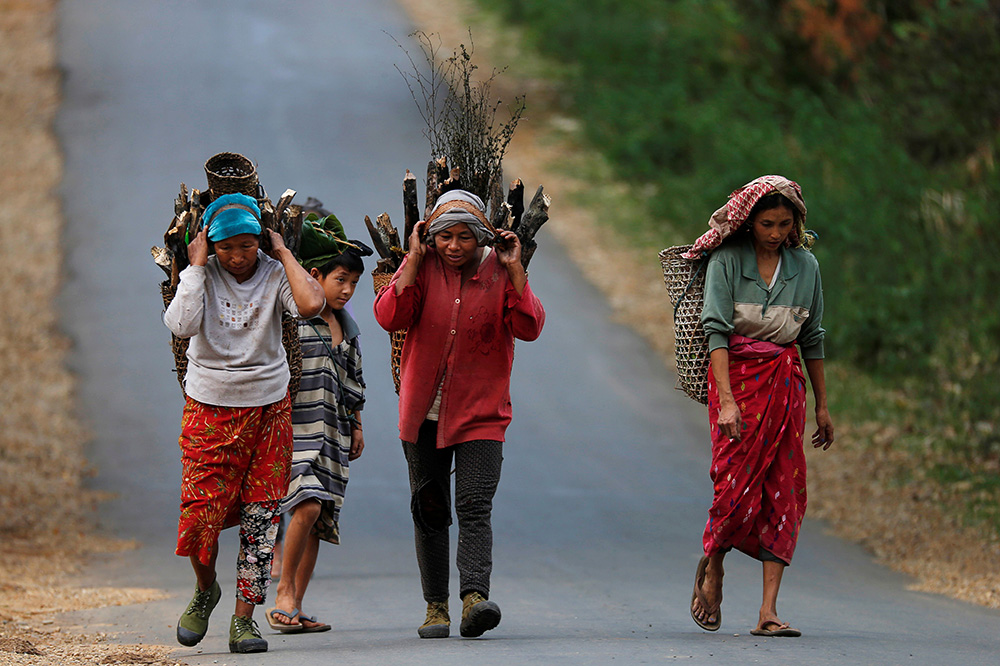
“Since the project was suspended, we keep thinking we will go back to our place,” said Roi Ja, who was displaced from Tang Hpre to the Aung Myin Thar resettlement area.
“Even though we are physically here, our minds are back there, where we lived,” she said.
Life in Aung Mya Tha is hard for the villagers, because the land on which they have been resettled is not arable, and cannot support the large-scale purchases that agricultural companies seek. This is driving local communities deeper into poverty and hardship; they have been forced to start their lives over from scratch.
“We cannot farm here. The land is rocky,” Ja Hkawn said.
Her former village of Tang Hpre supported diverse livelihoods and sources of income, including shifting highland cultivation, collecting forest products, panning for gold along the river, fishing, operating small grocery shops, selling and trading bamboo, and orchard farming; all of these activities were sustained by the local economy and relied very little on wider markets. The local economy, which relies on the local environment, had sustained them for generations, giving the community a high degree of self-sufficiency.
In 2006, the area in which Aung Myin Tha village now stands was submerged when the Chying Hkrang River flooded. The topsoil and all its nutrients were washed away, leaving the land in and around Aung Myin Tha unsuitable for grazing animals or growing crops. The area lacks job opportunities and access to natural resources, and is not good for fishing or panning for gold. Villagers can’t even collect firewood because the land near the new villages is owned by private companies.
“Almost all of our livelihood opportunities have collapsed,” Roi Ja said.
Most of the villagers were compensated with land plots, but they are 8 or 9 miles from the resettlement areas. “In the past, we could eat whatever we grew in our garden, so there was no need to buy anything,” she said.
“Since we need an income to make a living, most of us send our children to work in China,” she added.
As a result of the lack of farming, the villagers have to rely on SPIC’s irregular rice supply. Villagers said SPIC is supposed to provide a rice ration every three months—but sometime they fail to do so, and don’t provide a reason.
Ja Hkawn is one of the villagers who had their rice supply cut by SPIC in 2014 for participating in a protest against the Myitsone Dam. The company has also cut its rice supply to villagers who discuss their ordeal with the media.
“They stop supplying rice if we talk to the media,” Roi Ja said.
According to a government newspaper, the Chinese company spent about US$25 million on the resettlement plan. However, the villagers said they had to do major repairs on their houses in the resettlement village, as they were built with cheap wood. Most of them suffer leaky roofs when it rains, and their houses shake when there are strong winds. The windows and doors do not close properly. “The house looks fine and solid from the outside, but inside it is falling apart. We have no other options, so we just have to repair it,” she said.
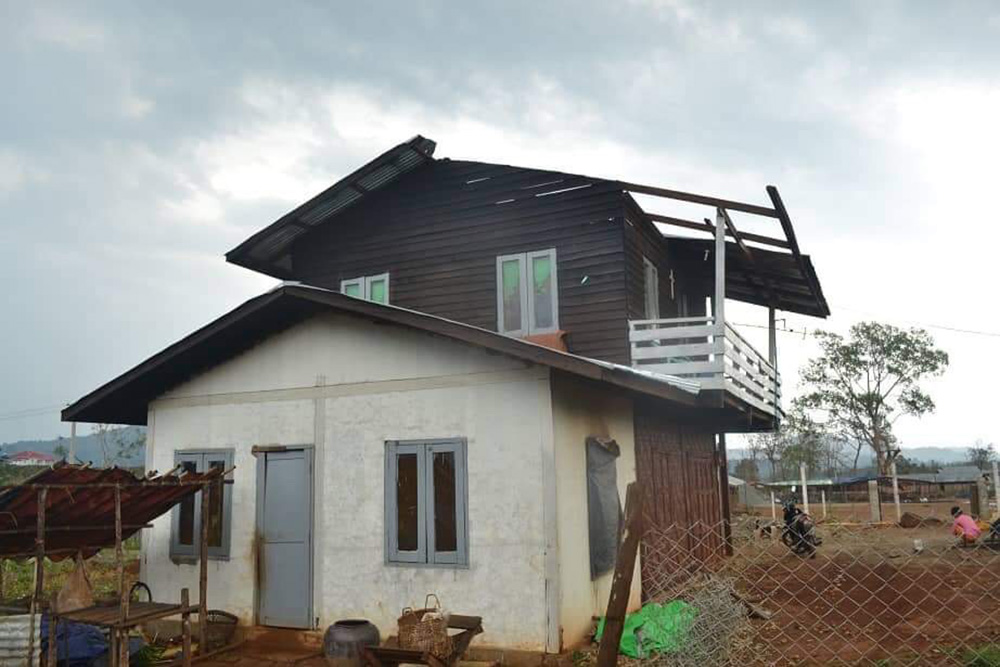
The Irrawaddy visited Aung Min Tha village and saw that most of the houses had been repaired by the villagers.
Environmental impacts
“Voices of the Unheard”, a report by local CSOs, said that since the resettlement process finished, big gold mining companies are operating on the land designated to be part of the dam’s reservoir. All these operations destroy the natural environment, turning the deep green forest into barren land, leaving no or little space for wildlife to survive.
At Myitsone, where once the river water was clear, visitors now see only muddy water filled with eroded soil.
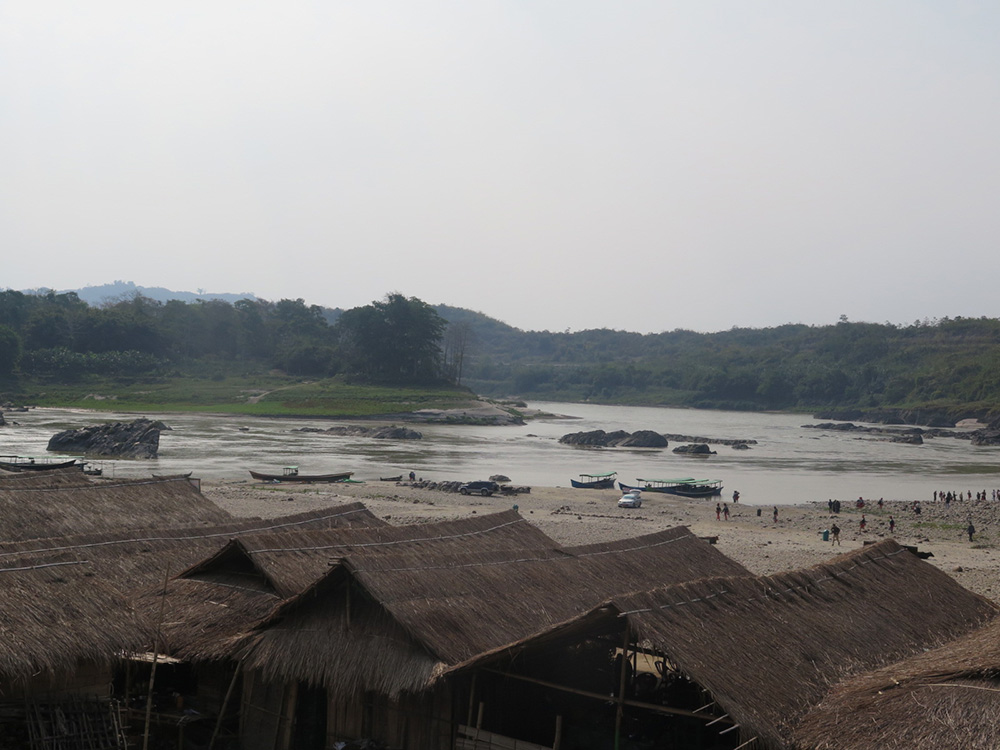
The banks of the May Hka River, once a vacation spot for visitors, are now off limits. A Chinese company has constructed a new road in the mountains linking to the project sites. About 4km from the confluence area, SPIC has already put up buildings on both sides of the river. Security staff are visible everywhere, making sure that no boats stop on either bank of the river.
Since 2010, villagers have lost access to their homesteads and farmland. The government has designated all farmland in the area as restricted government property. Local CSOs said that more than 50 villagers were temporarily detained by district and township administrators for going back to their land to farm. In exchange for their freedom, some people were forced to sign documents promising that they would never attempt to return to their old village for any reason.
According to the villagers, heavy machinery was brought in to extract resources both from above and beneath the soil, and around the confluence area, and to log all big and small trees, as the company levels the land in preparation for the dam’s construction.
“Even if the project is suspended, the companies still own our land,” Roi Ja said.
“One year after the project was started, those mountains were completely stripped of their trees,” said Ja Hkawn, pointing to the mountains along the bank of the May Hka River. “The trees regrew after the project was suspended. But the clear water has gone,” she said.
Solidarity for Myitsone
Beijing’s recent pressure has renewed negative sentiment against the Myitsone project across the country. It came under the spotlight again when Chinese Ambassador Hong Liang claimed after a visit to Kachin State at the end of December that the Kachin people were not opposed to the dam’s resumption.
Recently, Yunnan province’s senior leaders again pressured Kachin religious leaders to support the revival of the project during a meeting in the Chinese border town of Ruili. At the meeting between senior Yunnan provincial leaders and representatives of the Kachin Baptist Convention (KBC), Chinese officials told the Kachin religious leaders that Myitsone Dam was one of Chinese President Xi Jinping’s priority projects, and that their stand on the dam project has not changed.
In recent weeks, there were a series of protests against the dam in major cities including Yangon, Myitkyina and Pathein after Beijing showed its strong intention to revive the dam.
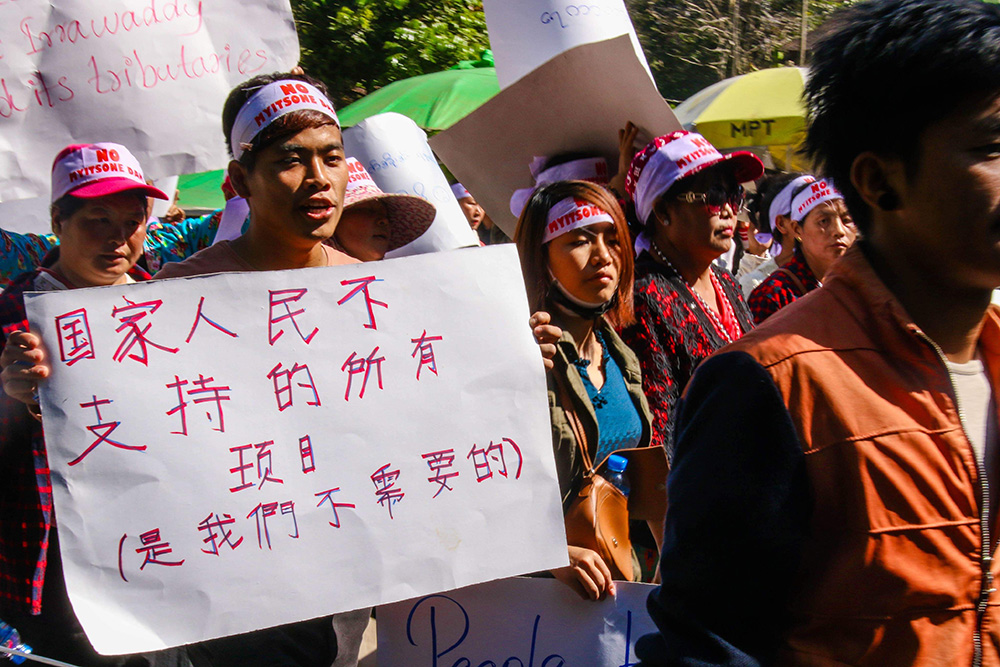
After leading around 10,000 members of the Kachin community in a protest in February demanding an end to the project, Ja Hkawn was hit with a lawsuit under Section 20 of the Peaceful Assembly and Procession Law.
In Waimaw, about 19 km from Myitkyina, the capital of Kachin State, more than 4,000 local people plan to stage another major protest against the dam in the first week of April. Waimaw is one of the townships downstream of the project, and residents there worry that their homes will be flooded if the dam were to break.
“The whole township will join the protest. We want to prove that the Chinese Ambassador’s statement is wrong,” said Bawn Sau a resident of Wuyan village and president of the Myitsone committee in Waimaw Township.
“China is pushing too hard because they want to restart the project very soon,” Bawn Sau said.
A sense of disappointment at the ruling party has arisen not only among local residents but also among anti-dam activists for not revealing the party’s stance on whether the project will be suspended indefinitely or restarted.
“We just want a straight answer. We don’t want to worry day and night anymore,” Bawn Sau said.
Prominent Kachin politician Manam Tu Ja, president of the Kachin State Democracy Party (KSDP), met Chinese Ambassador Hong Liang in December and voiced the community’s strong objection to Myitsone Dam.
“They know that we represent the Kachin people. That’s the reason they approached us,” Manam Tu Ja said.
Being aware of local anti-dam sentiment even local ethnic parties promised during the by-election campaign that they would oppose the Myitsone Dam.
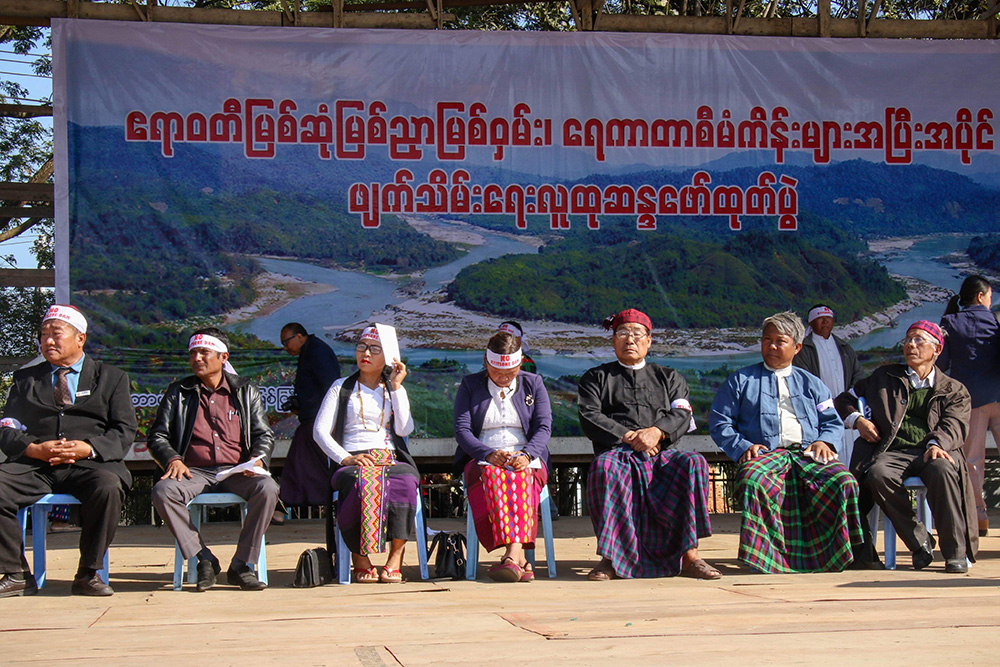
Manam Tu Ja and other Kachin politicians also joined the February protest march in Myitkyina calling for the termination of the dam.
“We are of one voice with the local people. We totally disagree with reviving the dam project,” Manam Tu Ja told The Irrawaddy at his home in Myitkyina last week.
“I can say that 99 percent of the people in Myanmar don’t agree with restarting the dam project. This number includes not only the Kachin people but also people across the country,” he added.
Kachin politicians feel that Myanmar has drawn increasingly close to China over the past year as relations with the West have frayed over its treatment of its Rohingya minority. Some critics of the dam worry Beijing’s growing leverage could pressure the government into striking a new deal on the dam.
In 2016, SPIC said Myanmar would owe it $800 million in compensation if the government cancels the dam, but could earn $500 million a year in revenue if it goes ahead. The government would also incur interest of $50 million for every year the project was suspended.
After taking office, the National League for Democracy set up a 20-member commission including the chief minister of Kachin to review the dam and its likely impacts on the environment and local communities. The commission has produced two reports to date, but the government has yet to release either.
In late January, U Thaung Tun, minister of investment and foreign economic relations, said the government and a commission studying the project are in very serious discussions and considering all possibilities, including downsizing the dam, relocating it or developing other projects instead.
“I don’t think downsizing or relocating would work. We don’t want a dam project on the Irrawaddy River. Chinese companies are already working on upstream dam projects on both the Mali and Ma Hka rivers. Enough is enough. They should scrap the project entirely,” Bawn Sau said.
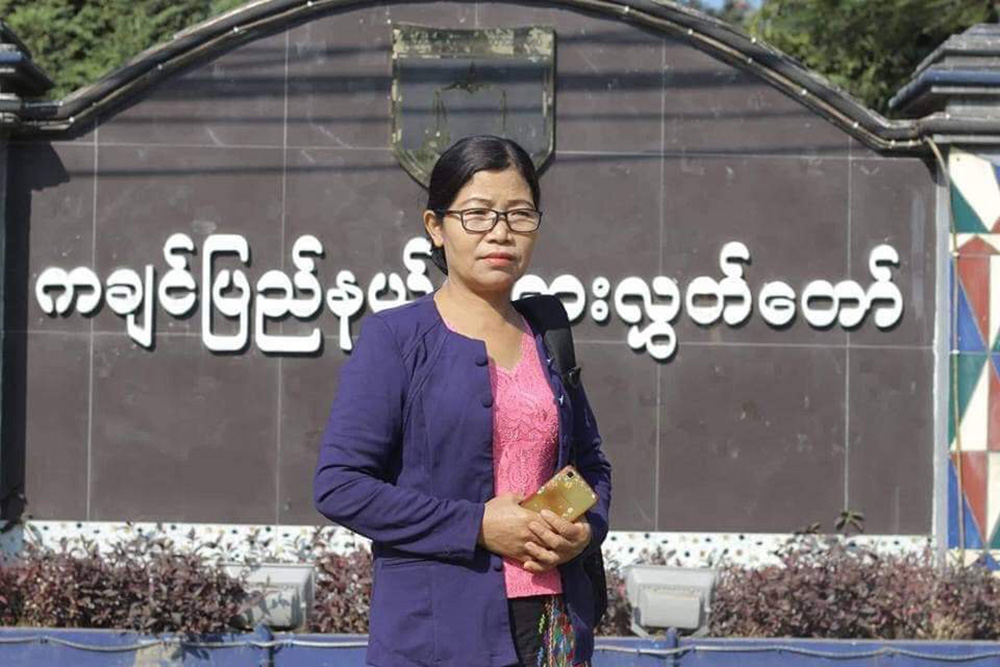
The archbishop of Yangon, Cardinal Charles Bo, also said the dam project “must be stopped” to ensure a peaceful future for the country, adding that the construction of the dam would be a “death sentence for the people of Myanmar”.
Meanwhile, prominent civil society leaders, environmentalists and anti-dam activists have formed a nationwide committee in Yangon to show solidarity against the Myitsone project.
Well-known environmentalist Devi Thant Cin told The Irrawaddy that even the quasi-civilian U Thein Sein administration suspended the project for five years. “Why not the NLD? They are a government elected by the people.”
“I want the NLD to live up to its campaign slogan, which said it would ‘stand with the people,’” she said.
“When it comes to building a good relationship between the two countries, China can’t build a relationship only with the government. They also need to build a good relationship with the people of this country. I would like to remind China not to forget to build a relationship with the people of Myanmar,” she added.
The waves of opposition to the dam from local people, environmentalists, politicians and activists show that the NLD needs to send a clear message to the people, or it will face serious resistance across the country.
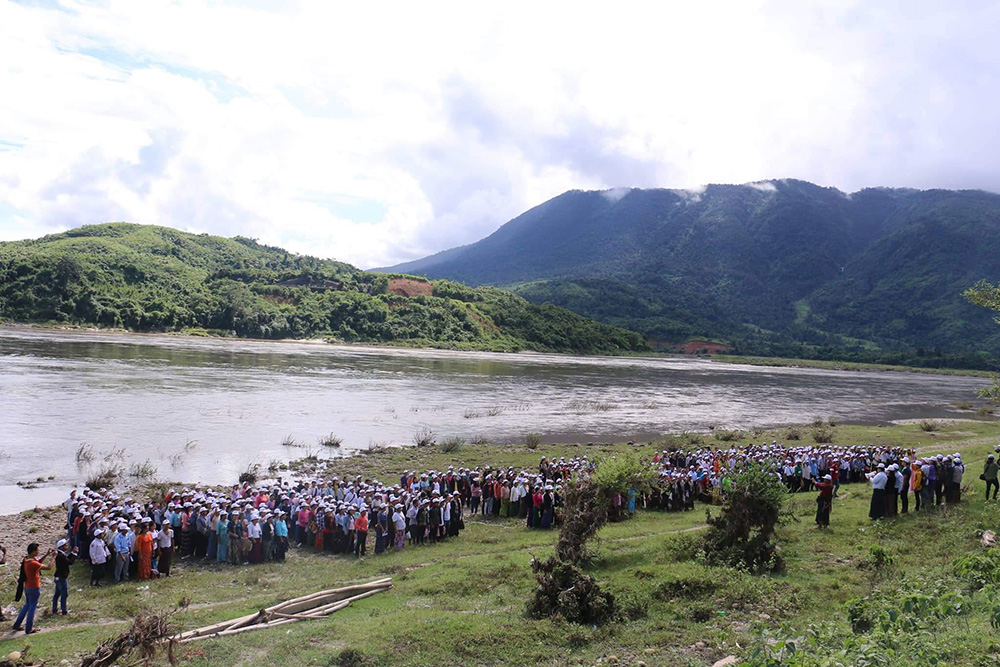
“The Irrawaddy is the lifeblood of this country. It is not only a Kachin State issue, but also a national issue. If they build a dam across the throat of [the country’s] lifeline river, it is like killing all the people in Myanmar,” Ja Hkawn said.
“I don’t hate the Chinese. After all, we are neighbors. They should listen to what we are requesting,” Ja Hkawn said.
“I hope that they [the SPIC officials] will go back their country peacefully,” she said.
















